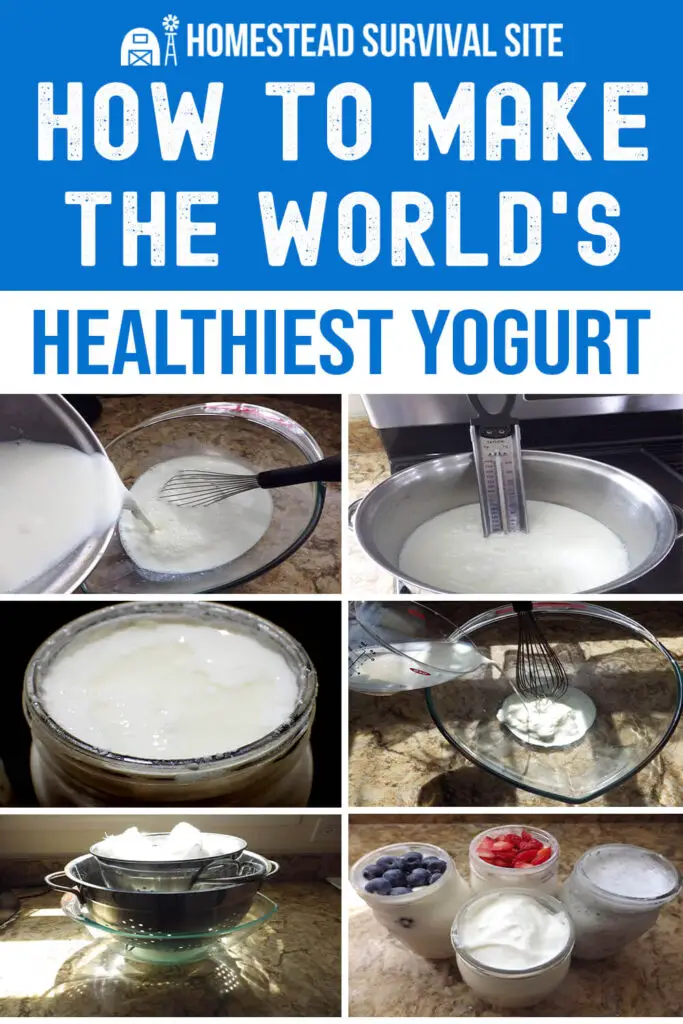Estimated reading time: 15 minutes
Yogurt has emerged as one of the superfoods we should eat as a regular part of our diet. One of the primary benefits is the probiotics. This is a collection of certain beneficial bacteria that enhance overall “gut health” to improve digestion and actually stimulate our immune system. But there’s a problem…
Most Store-Bought Yogurts Fail
It’s one thing to use a bacterial culture to make yogurt and then put a big promise on the label about probiotics. It’s another thing when sugars are added to the yogurt. In actual fact, sugars kill the probiotic bacteria during digestion and even on the shelf.
There may be some surviving good bacteria in the product on the shelf, but it won’t make a difference if they don’t survive after you eat it due to the sugars.
Want to save this post for later? Click Here to Pin It On Pinterest!
It Gets Worse…
Many yogurts are loaded with artificial colors, artificial flavors (sometimes disguised with the obtuse term “natural flavors,”) and a list of preservatives and thickening agents from guar gum to carrageenan to starch.
Collectively everything in up to 85% of store-bought yogurts is so overloaded with artificial ingredients that any health benefits and claims are negated. What you’re left with is actually an unhealthy dose of added sugars, and most of those artificial things that few people think of as healthy.
Everything You Need To Know About Buying Yogurt – Greek, Organic, Grassfed, & More
Read the Label!
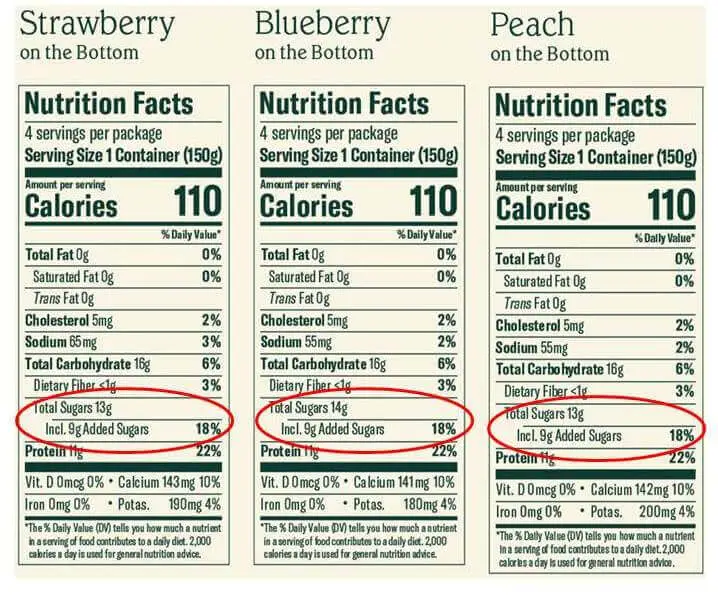
Above are some labels from a popular yogurt brand. Most of it looks pretty good, but there’s something jumping out worth noticing. It’s the sugars. Some of the sugars are fructose from the fruit that may have been mixed into the yogurt. That’s not all bad unless you’re diabetic and watching your sugar intake.
The glaring addition is the added sugars. Mass-market food processors are notorious for adding cane sugar (sucrose or sucralose), fats, and salt to foods to enhance flavor. Four grams of added sugars equals one teaspoon.
In the above examples, nine grams of sugar is added so you’re getting more than two teaspoons of added sugar to each serving. Added sugars are never described as the “healthiest” option for any food.
Your complete guide to choosing a yogurt to meet your needs.
But It’s Not Just About Sugar
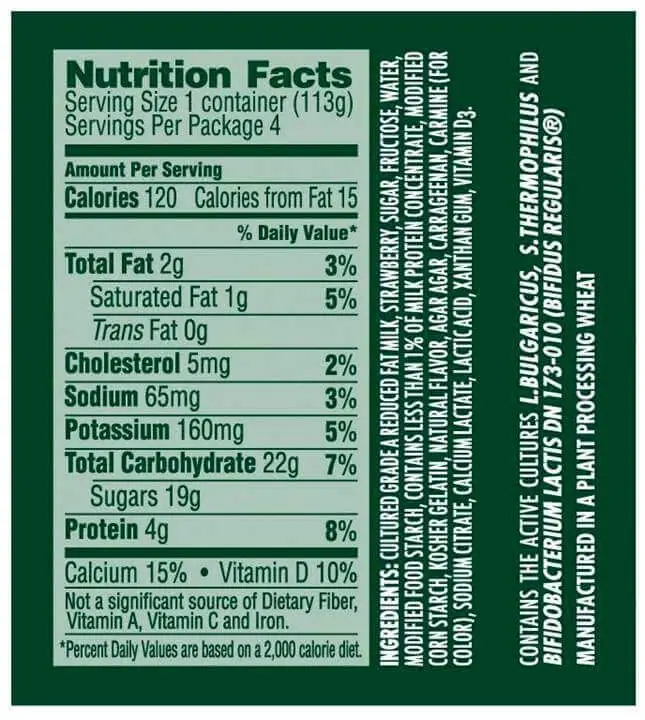
If you look at the sugars for these two yogurt flavors, it looks pretty good. Only 7 grams of sugar that seem like they might originate from fructose, and no added sugars. But if you look carefully at the ingredients it tells another story.
Here are some highlights from the ingredients:
- Modified food starch
- Natural flavors (not really natural)
- Carmine (food coloring)
- Kosher gelatin
- Acacia gum
- Pectin
- Xanthan gum
- Inulin
- Sucralose (so the sugars are not fructose!)
- Acesulfame potassium
On the surface, the nutrition facts seemed to report few sugars and a pretty good list of benefits. Unfortunately, the ingredients tell another story. And there are some characteristics of ingredients that are not mentioned.
The first ingredient listed is cultured nonfat milk. In case you’re wondering, that’s another way of saying skim milk. There’s nothing wrong with skim milk, but it doesn’t make the best yogurt, and much of the alarm about fats in our diet are overstated relative to the enormous amounts of sugar.
There are Some Good Brand Choices
Like anything else, some brands in grocery stores get it right. As usual, they’re more expensive and sometimes hard to find, but when you find them, you'll at least have a truly healthy option. The question is whether or not you can afford them on a regular basis let alone find them.
What the Healthiest Yogurts Have in Common
Consider this a litmus test for a healthy yogurt and the foundation for our recipe for the world’s healthiest yogurt. It’s the type of ingredients (and lack of certain ingredients) that creates the healthiest profile:
100% Organic
The word organic was so used and abused by food manufacturers that the USDA stepped up and created a standard signified by a seal that certified something was in fact 100% organic.
In actual fact, this organic designation is strictly enforced by the USDA, so any ingredients used to make yogurt needs to carry this seal if you want to create the world’s healthiest yogurt.
It’s “Greek” Yogurt
Greek yogurt has one fundamental difference from conventional yogurts. It’s filtered or strained to remove the whey from the culturing or fermentation process that turns milk into yogurt. The result is that it takes 4 cups of milk to make one cup of Greek yogurt, creating a yogurt with a thick and creamy consistency.
Conventional yogurts are not strained, so 4 cups of milk gives you 4 cups of yogurt. That’s why Greek yogurt costs more, and it’s a good bet that’s why mass-market food processors use thickeners like guar gum and carrageenan to simulate the creamy consistency of Greek yogurt, while getting every ounce out of the milk they started with.
The benefit of a Greek style of yogurt is a higher concentration of nutrients including protein, Vitamin B12, B2, selenium, calcium, phosphorous, zinc, pantothenic acid, Vitamin A and potassium. That’s all good stuff, and that’s what we want when we make our yogurt.
Another benefit is that filtering out the whey filters out some of the lactic acid. There’s still some left, but if someone is lactose intolerant, they may be able to tolerate a Greek yogurt rather than a traditional yogurt. This also filters out some of the natural sugars which could help some people with diabetes.
But once again, be forewarned. Just because it says “Greek” yogurt on the label at the grocery stay doesn’t mean it’s automatically healthy or good for you. Read the label to see if they add those sugars and other artificial ingredients.
Only Fresh Fruits are Added
What we’re going to make is a plain yogurt from organic milk and a yogurt culture or starter, although you can use some plain, organic yogurt added to the milk instead. What we’re not going to add is anything else, although some people aren’t thrilled with the bland flavor of plain yogurt (especially kids).
To compensate for any lack of flavor, one option is to add fresh fruit to your yogurt. We’ll cover how to prepare and when and how to add the fruit, but that can help if you want to add some flavor to your yogurt.
Then again, you could just spoon your plain yogurt over a bowl of fresh fruit, and that will take the edge off a plain taste. If you want to keep things in the “healthiest” profile, use only organically grown fruits. Your own garden may be the best source.
It’s rare that only fresh fruits are added to most grocery store yogurts and even then, they’re often accompanied by a good share of artificial flavors or those so-called “natural” flavors, and added sugars.
Artificial Sweeteners?
If you simply can’t sustain a steady diet of plain yogurt, you could use an artificial sweetener, but be careful. The best artificial sweeteners are natural derivatives like pure Stevia or Monk Fruit. But here again, there’s some bait and switch on the grocery store shelves.
Make sure you buy 100% Stevia or Monk Fruit. They’re usually sold as a liquid extract. Try to avoid those products blatantly called “Stevia” or “Monk Fruit” that have Erythritol or other artificial sweeteners as the primary ingredient with a little bit of the Stevia or Monk Fruit added.
Recipe for the World’s Healthiest Yogurt
This actually isn’t all that hard, assuming you’ve been able to find the best organic ingredients. You could probably finish your yogurt by the end of a day and make as much as you want.
It’s also unlikely that you’ll be adding artificial flavors, colors, or preservatives. Most of us don’t have a whole lot of those things in our kitchens.
Equipment
- Large stainless steel or enameled pot (Do not use aluminum cookware)
- Cheesecloth
- Large glass bowl
- Mason jar(s)
- Metal spoons for stirring (don’t use wooden spoons because of possible cross-contamination from bacteria on the wood).
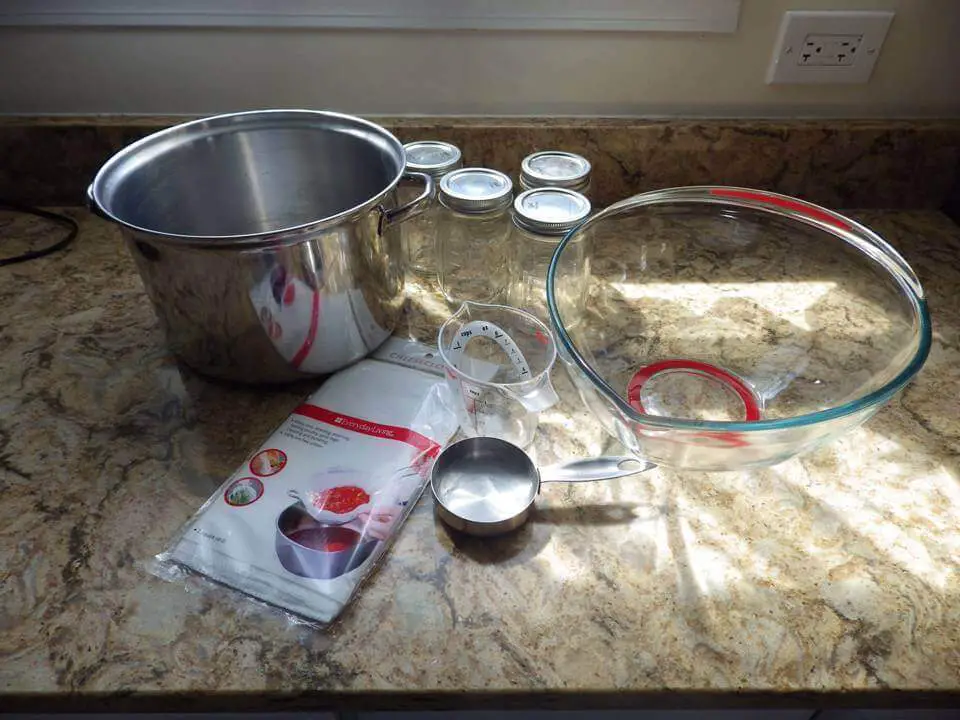
Ingredients
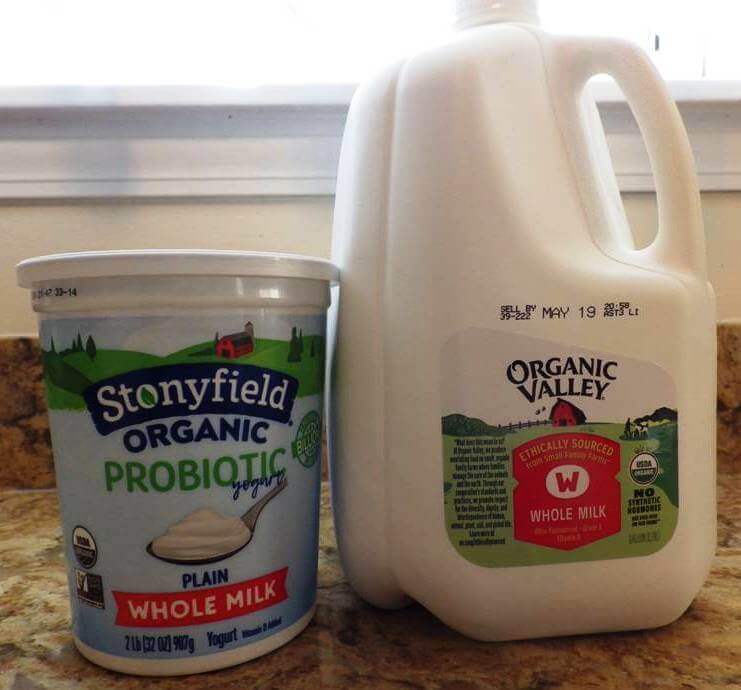
- Organic whole milk. Ideally, it is from cows that have been 100% grass fed but not critical. The label should also have the USDA organic seal. You can find it at Walmart and many other grocery stores. It costs more—about twice as much as a regular gallon of milk. For some reason healthy is rarely cheap.
- Yogurt starter or culture. This is the active probiotic bacteria that triggers the fermentation process to turn milk into yogurt. Some grocery stores have it, usually in their specialty cheese section. You can also buy it on Amazon. Then again, if you have some leftover yogurt from a previous batch, or can buy a 100% organic, plain yogurt –you could use some of that yogurt to trigger the fermentation process. If buying yogurt look for a brand that states “live probiotics cultures” on the label.
Directions
1. Pour the milk into your pot and heat to 185 degrees F. You can use as much or as little milk as you want. It all depends on how much yogurt you want to make. We started with a ½ gallon. The reason you’re heating your milk is to kill any residual bacteria in the milk. You only want the good “yogurt” bacteria fermenting and culturing your milk.
2. Let the milk cool down to at least 110 degree F. (lukewarm).
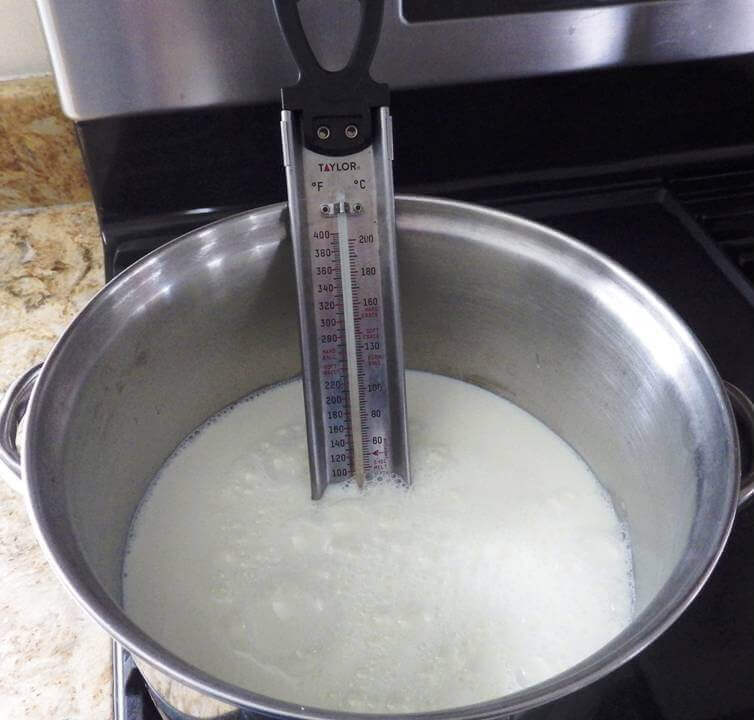
We’re going to make this simple and just use a cup of some plain, organic whole milk yogurt to start our new yogurt culture. If using a yogurt starter powder, follow the directions on the packet (it varies). Using an organic yogurt as a starter makes it all easier.
3. Add 1 cup of your plain yogurt to the bowl and then add a cup of your lukewarm milk and whisk until blended.
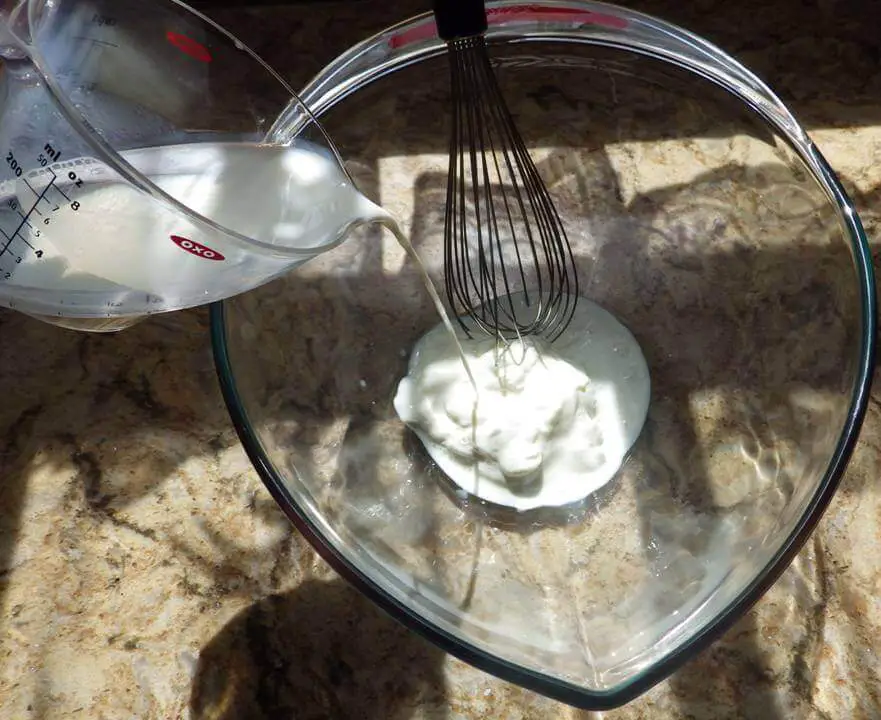
4. Add the rest of the milk to the bowl and whisk together.
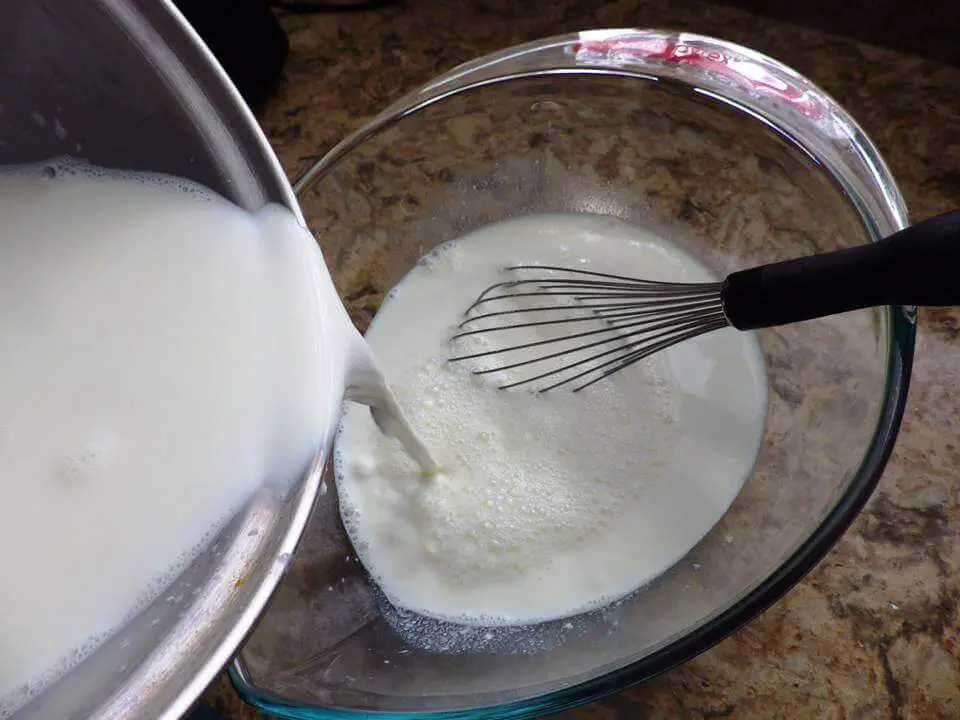
5. Pour the milk mixture into sterilized mason jars or other container, seal and let sit in a warm place for 24 hours.
You want to try and maintain a temperature around 110 degrees F.

One way to keep them warm is to put them in an oven with only the oven light on. That will actually keep the oven lukewarm. You could also put it in a large food dehydrator at 110 degrees if you have one.

And you don’t have to worry about sealing your jars or container. The fermentation process with yogurt does not release carbon dioxide gas like some other fermenting foods. Instead, it releases a mild acid which is what makes yogurt have a somewhat sour, piquant flavor. And by the way, that same acid is what makes sour cream sour.
6. After 24 hours, check the yogurt and see if fermentation has taken place. If it still looks too runny, let sit for another couple of hours.
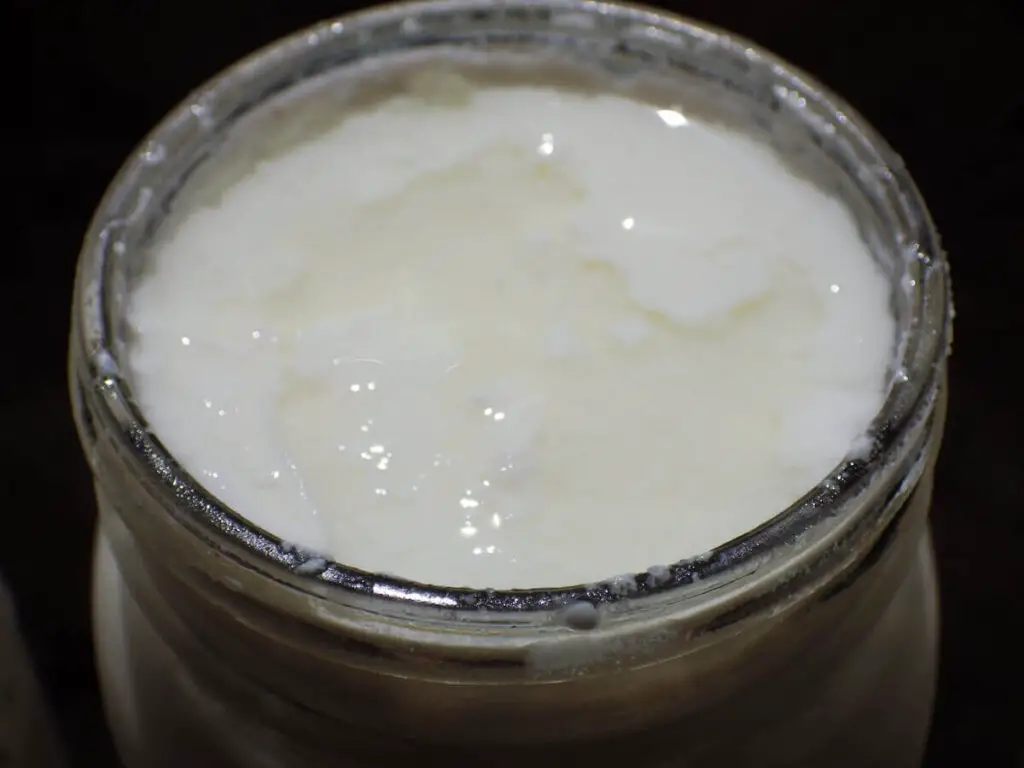
You could also add some more fresh yogurt and shake to jump-start it. Once you’re satisfied with the consistency, give it a taste.
7. If it tastes like plain yogurt, you're ready to strain the yogurt by suspending the cheese cloth over a large bowl allowing the whey to drip though and out.

8. Test the consistency of the yogurt trapped on the cheesecloth with a spoon and when it has the thickness you like, spoon the yogurt into sterilized canning jars and store in the refrigerator.
Some people save the whey in the bottom of the bowl to add to recipes or to use as a starter for another batch of yogurt.
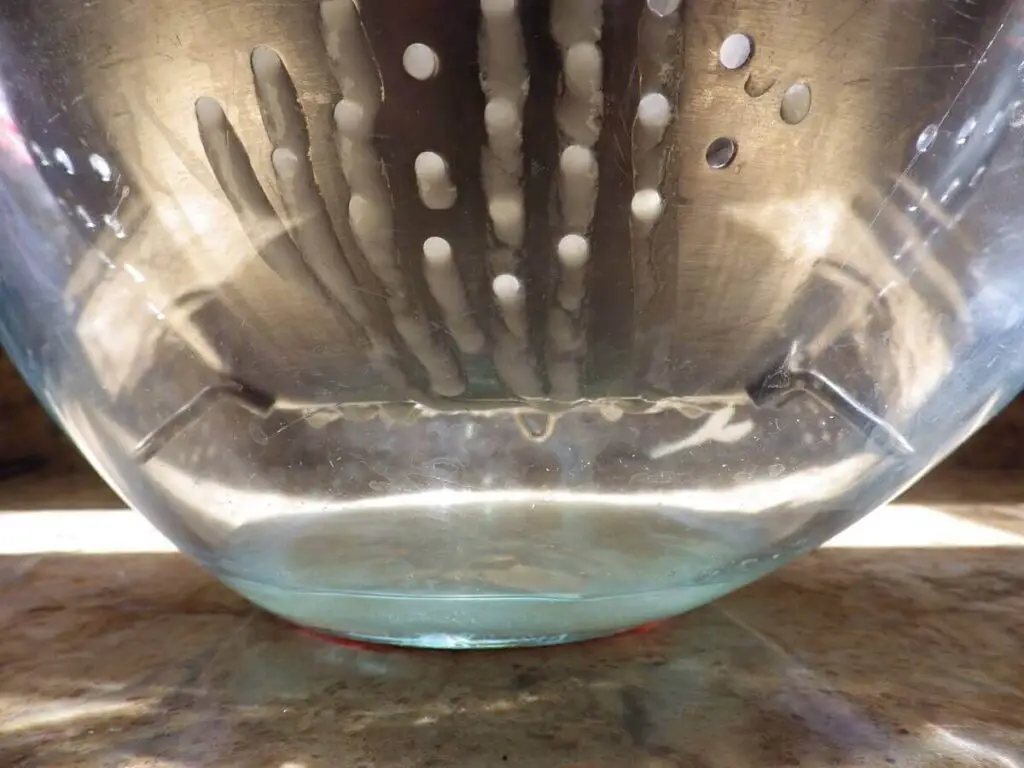
9. Seal and refrigerate the yogurt in canning jars or other tightly sealed containers. It should be good in the refrigerator for 2 to 3 weeks.
Possible Plus Ups
There are a few things you can do with your plain, homemade Greek yogurt to plus up the flavor and the nutrition. You can actually do this with any yogurt you buy, but in our effort to make the world’s healthiest yogurt, it’s worth considering these ideas…
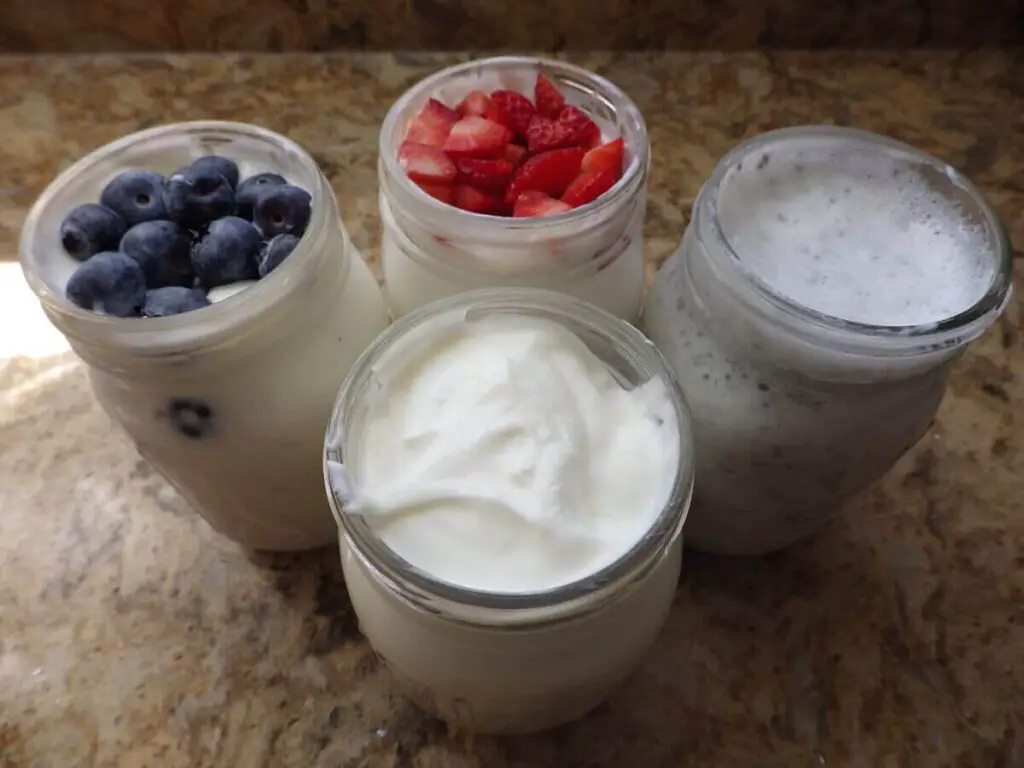
Add Chia Seeds
Chia seeds are all the rage these days and for some pretty good reasons. They’re another way to add to overall digestive health plus they deliver a good amount of added protein, Omega-3 fatty acids, and added fiber.
Add about a tablespoon of whole chia seeds to a half cup of milk and let sit for 5 minutes. After 5 minutes, stir mixture and add to your yogurt. Let the chia/yogurt rest for 2 hours in the fridge and you’re good to go.
Add Flax Seeds
Flax seeds are another possibility although they’re a little more complicated. You’ll need to grind or process the flax seeds to break them up. Whole flax seeds pass through your digestive tract with little benefit. They need to be cracked open.
However, you don’t want to buy cracked flax seed. They don’t have a great shelf-life when cracked so buy them whole and process them before adding to your yogurt.
There’s no need to add them to milk like chia seeds. Just mix them into your yogurt and give them a couple of hours in the fridge to soften up and blend.
Add Fresh Fruit
We mentioned this a little earlier. You can add any kind of fresh fruit, but most people stick with berries like blueberries, strawberries, raspberries, or blackberries. You could also cut apples or pears into small pieces or blend a ripe banana into your yogurt in a blender.
In fact, it’s a good idea to coarsely blend any fruit you want to add to your yogurt in a blender first. That maintains the fiber on the skins of the fruit, but will also allow the color and flavor to permeate the yogurt better. And then some people top their yogurt with a big sprinkle of flaked coconut.
Add a Sweetener
Some people add raw honey or real maple syrup to their homemade yogurt. That’s up to you and your diet. If adding an artificial sweetener try to stick with the 100% Stevia or Monk Fruit alternatives. If you’re really trying to make the healthiest yogurt you’ll want to avoid all other sweeteners especially cane sugar and corn syrup.
You May Never Have to Buy Yogurt Again
Once you’ve made your own yogurt, you’ll discover how easy it is to make and most importantly, you'll be able to customize it to suit your tastes and your diet.
Just remember that the purity and the integrity of the ingredients ultimately determine the quality. It’s not hard to do, and in the long run, making the world’s healthiest yogurt will be both inexpensive and absolutely great for you.
Like this post? Don't Forget to Pin It On Pinterest!
You May Also Like:



